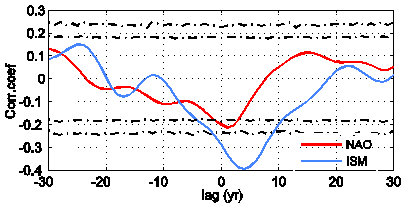There is a close relationship between the North Atlantic Oscillation (NAO) and the Indian summer monsoon (ISM) rainfall on the inter-annual timescale. However, the relationship between the NAO and the ISM rainfall on inter-decadal timescale is still under-debate. In view of the external forcing factors’ (both volcanic eruptions and solar irradiance) impact on both ISM rainfall and NAO, the external forcing factors may lead to the statistical relationship between the ISM rainfall and the NAO.
Scientists from Institute of Atmospheric Physics (IAP) use reconstructed data and the 600-yr integrations performed with the Bergen Climate Model to investigate the impact of external forcing factors on the Indian summer monsoon (ISM) rainfall, the winter North Atlantic Oscillation (NAO), and the potential relationship between the ISM rainfall and the NAO on decadal to inter-decadal timescales. The model simulations include a 600-yr control integration (CTL600) and a 600-yr integration with time-varied external forcing factors from 1400 to 1999 (EXT600). Both reconstructed data and the simulation showed increased ISM rainfall 2-3 years after strong volcanic eruptions. Strong volcanic eruptions decrease the Indian Ocean sea surface temperature (SST), which increases the strength of the southwesterly winds over the Arabian Sea. With negative externally-forced radiative anomaly, the lower stratospheric pole-to-equator winter temperature gradient is enhanced, leading to a positive winter NAO anomaly with a time lag of one year. There is no significant correlation between the winter NAO and ISM rainfall in CTL600. However, the ISM rainfall is significantly negatively correlated with the winter NAO in EXT600, with the NAO leading by 2-4 years, which is consistent with the NAO-ISM rainfall relationship in the reconstructed data. They suggest that external forcing factors regulate the inter-decadal variability of both the winter NAO and the ISM rainfall and thus likely lead to an increased statistical but not causal relationship between them on the inter-decadal timescale over past centuries.
Their finding was recently published in Climate Dynamics.

Fig. 1 Lead-lag correlation coefficients between the external forcing index (TEFI) and the winter NAO (red), between the TEFI and the ISM (blue)
References:
Cui, X., Gao, Y., Sun, J., Guo, D., Li, S., Johannessen, O. M., 2014: Role of external forcing factors in modulating the Indian summer monsoon rainfall, the winter North Atlantic Oscillation and their relationship on inter-decadal timescale. Climate Dynamics, 43, 2283-2295. doi: 10.1007/s00382-014-2053-4






